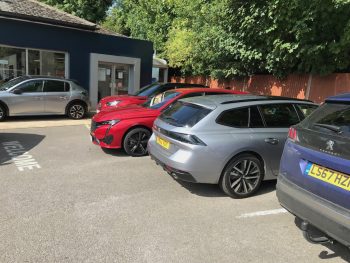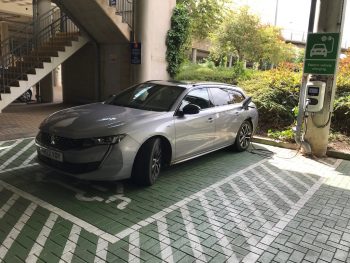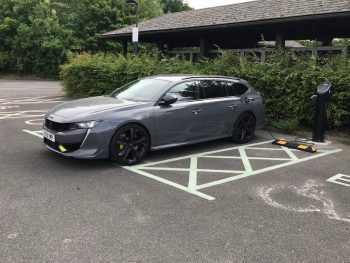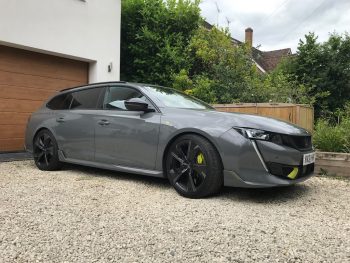Fleet World Fleet: Peugeot 508 SW GT PHEV
Nat Barnes fesses up to a schoolboy error with our 508 SW GT plug-in hybrid.

User error meant a visit to Eden Peugeot was largely unnecessary
Peugeot 508 SW GT PHEV
List price (BiK): £40,130 (12%) CO2: 34g/km MPG/ EV range: 200.8mpg / 33-39mls Test efficiency: 74.2mpg
Report 7:
It’s the automotive equivalent of that moment in the supermarket. You know the one. Where you search in vain for the Marmite or eggs (or in editor Challen’s case, the free-range, privately educated caviar in 5kg tins), then finally give up and ask an assistant, only to find you’re standing right next to it.
That’s exactly how I felt in Eden Peugeot as the very polite service manager pointed out the error of my ways with my long-term Peugeot 508. Regular readers will remember me struggling with Apple Carplay which just refused to work in the 508. The reason why, it turned out, was down to pure user error – I had plugged the lead into the wrong USB port (there are two) and the one on the driver’s side is obscured from view by the steering wheel. Once the lead was plugged in to the correct one, it worked perfectly well.
In a vague defence against my utter stupidity, the system did need updating (hence the past occasions when the whole screen refused to work), so there was still a requirement to visit the dealer after all. Well, that’s my excuse and I’m sticking to it. The second factor in my fragile defence was also that even the servicing department had been unaware of the issue with the two difference ports until a recent training session.
Still, all the local miles I’ve been doing recently have enabled my average fuel economy to recoup following my largely charging-free trip to Devon in the summer. It’s already recovered back to 74.2mpg and I figure the more electric miles I do, the higher that figure will go. And with that in mind it’s slightly frustrating that I’ve not yet seen a fully charged range figure starting with a ‘3’ as yet. The highest I’ve had has been 28 miles. I excused the PSE its pitiful EV range due to its performance aspirations, but I expected more from the GT. Again, I’m hoping that with more miles on the odometer, it will ‘learn’ my driving and rise accordingly.

Our new 508 SW GT PHEV
Report 6:
After three months with the PSE, if I was expecting familiarity with the 508 to ease the arrival of the GT PHEV to the fleet, then I was wrong.
It’s been something of a baptism of fire for the GT. Was stated in my last report it’s booked in to my local Peugeot dealer to have the Apple Carplay and touchscreen looked at, which hopefully will resolve things. A month-long wait for a booking was frustrating, but given a couple of occasions where the entire screen has frozen, I’m already concerned that the problems will be more complicated than a simple ‘switch it off and on again’. Fingers crossed.
The GT hasn’t had the easiest of starts either. A holiday trip to Devon was a great way to stretch its legs, but despite having a holiday rental home with an EV charger, we didn’t get to use it. The reason why was a flat rate charge of £35 by the landlords.
Call us Scrooge, but that’s the equivalent of 500-600 miles which is hard enough to do on a five-day holiday in a full EV, let alone in our plug-in hybrid. Plus, the owners also expressly forbade use of a granny charger, despite me using one at home for all my charging.
No doubt charges like this will become the norm in time, but it did leave a sour taste in my mouth – especially forbidding granny chargers. Don’t get me wrong, I’d be happy to pay to use the charger, but £35 seemed a bit steep to us.
Thankfully I did manage a couple of top-ups at public chargers while out on day trips, but the resulting lack of charging has meant that the 508’s average economy has dropped faster than throwing editor Challen’s wallet out of the window of his top-floor luxury penthouse apartment. Now we’re back into our more usual driving routine, I may reset the trip computer to give the average a fair chance to recover.

Our Peugeot 508 PSE is being replaced with a 508 GT
Report 5:
Peugeot 508 PSE SW
List price (BiK): £55,795 (14%) CO2: 46g/km MPG/ EV range: 138.9mpg / 26mls Test efficiency: 98.4mpg
As one door closes, another one opens. Or, in the four-wheeled terms of the Fleet World long-term garage, as the Peugeot 508 PSE leaves, a 508 GT arrives.
Our three-month stint with the 508 PSE was certainly a memorable one, for both all the wrong and the right reasons. Nobody, not even Peugeot, would pretend that the flagship 508 PSE was a typical business car, but as my staggering 98.4mpg average fuel economy showed, with judicious and regular charging, it’s not beyond possibility that the plug-in hybrid technology can work for you – even if it’s more focused towards performance than ultimate economy.
The PSE was also a pretty respectable driver’s car too, it’s just that the combined nature of both a family car and the plug-in hybrid tech meant that the opportunities to flex those driving muscles were somewhat few and far between during our brief tenure.
With the arrival of the 508 GT however, one element of the PSE that I certainly won’t miss though was its ride quality. As I’ve said here before, nobody buys a PSE expecting a Rolls Royce-like ride, but on 20-in alloy wheels (compared to the 18s on the new GT), the difference in ride quality was immediately obvious for the better.
Yes, we’ll miss the PSE’s head-turning looks and styling, but the GT’s comfort levels are already making up for that. Aside from a few details and less interior comforts such as massaging or heated front seats though, the inside is much the same. Our first stop, however, will be to our local Peugeot garage as the GT’s Apple Carplay isn’t working and the entire touchscreen has already frozen on a couple of journeys. Fingers crossed it’s a quick fix.

Our tester pretty much put all of the 508 SW’s 1,780 litres of boot space to good use
Report 4:
As the last review was focused on the Peugeot 508 PSE’s performance, both in terms of its pace and also its parsimony, I thought it was about to time to focus on another ‘P’ – practicality.
It’s odd to think that not so long ago, a car manufacturer having an estate car in their line-up was pretty much a necessity – especially so for the business market. Now though, thanks to the proliferation of crossovers onto the market, despite their everyday practical advantages, estates have almost become a novelty, particularly so when it comes to plug-in hybrids.
Compared to their crossover equivalents, estates are usually more economical, have more space and are cheaper to buy and run. But if you’re after a plug-in hybrid estate car like the 508, there isn’t a lot of choice to be had. And, call me as up to date as an oil lamp, but I will always prefer an estate car to a crossover and I’m sure I can’t be alone.
A good reason for that preference was underlined with some home DIY that I’ve been undertaking recently. With a lot of wood and an old broken-up log store to dispose of, I needed to pay a visit to the local dump. In the interests of full disclosure, I’d also like to point out that no car interiors were harmed in the making of this main picture.
With the rear seats folded down, the 508 SW boasts a substantial 1,780 litres of boot space (530 litres with the seats are up) which, crucially, is exactly the same as the petrol or diesel models – not the case with many PHEVs. While there were still a few wafer-thin gaps, it’s fair to say I utilised the majority of those 1,780 litres of space on the way to the dump, for the sheer reason that I didn’t want to make a second trip. But it just underlined how good traditional estates can be when you need a workhorse rather than a lifestyle car.

The Barnes family have been putting a toe in the water testing our 508 SW PSE
Report 3:
I’ve been undertaking some longer journeys in the 508 recently. For any standard petrol or diesel car that would be something of a ‘so-what’ statement; but of course, long journeys are the bane of any plug-in hybrid, which are better suited to lots of shorter trips where the electric range can be taken advantage of.
So, I must admit to not having had high hopes for the 508 PSE, especially on a particular day of a 230-mile round trip. That was made even more so by an odd malfunction that saw the car tell me that the electric mode wasn’t available despite a full charge, something I’ve already experienced before when it was quickly resolved by the old IT specialist trick of ‘turn it off and on again’.
With those 230-plus miles, the electric range would probably barely cover 10% of the total distance at motorway speeds, so I reset the trip computer for a little experiment. By luck, I managed to sneak a brief charge at my destination (ironically queuing behind editor Challen in his BMW iX3); enough to give me a further 22 miles of EV range displayed for my return journey. But by the time I returned home, my average fuel economy for the day was reading at 67.3mpg which I was quite impressed by. Yes, it’s down on my overall three-figure average, but that 67.3mpg is still on a par, if not better than, a really good diesel.
A handful of days later was a trip of a different kind with a hour-long cross-country route down fast and winding A-roads. I must admit to not having really flexed the 508’s sportier muscles too much yet, as normally I have the family on board. Here though, I was able to take advantage of the PSE’s performance and sharp turn-in and enjoy its enthusiast-led characteristics.
Yes, my average economy for that particular journey probably dropped faster than editor Challen’s hand when it’s his round, but the smile on my face as I pulled up at my destination was definitely worth it. Sometimes, you just have to let your heart rule your head…

Helped by the warmer weather, we’ve been achieving the claimed 26 miles for the 508 SW PSE’s fully electric range
Report 2:
In my last review, I made a passing mention to just how many compliments the Peugeot 508 PSE SW gets. That has shown no sign of abating so far, as almost everyone who sees the 508 comments on its styling and good looks.
On top of the standard 508, the PSE’s body kit adds in lowered suspension, Selenium Grey paintwork and huge 20-inch ‘Exxar’ wheels, ensuring it turns plenty of heads. We also like the luminous green highlights on the bodywork and the brake calipers too.
It’s not all perfect though. Those huge alloy wheels and low-profile tyres (245/35s) make for a firm ride and very annoyingly it’s all too easy to graze them when parking, despite being careful. They also make for a pretty firm ride too which, for a family car, isn’t always ideal.
The same goes for its low-slung nature; we live on a hill and have found we have to back in at a very defined angle to avoid catching the underside as we pull into our drive.
Of course, for many drivers a lot of that is possibly academic, as you don’t really choose a car like the 508 PSE by mistake, but it’ll be interesting to see how we feel when we switch it for the standard plug-in hybrid later on.
The real benefits of the 508’s plug-in hybrid tech are obvious too, with its 114mpg average fuel economy so far. I’ve run plug-in hybrids before and it almost goes without saying that they’re at their best when you maximise their electric range. Mentally, I’ve always run PHEVs down until their EV range is showing single figures before charging up, but the PSE’s system is obviously tuned for performance rather than economy.
The good news is that with the warmer weather of late, I’ve been regularly matching the claimed 26 miles as the fully charged range. The bad news is that this obviously only requires a trip of eight miles before I’m into those single figures, so I’ve been charging pretty frequently.
Is that a pain? Not really, but you do have to be fastidious about charging. My thoughts, as always, are that while not free, those 26 miles are always going to be the cheapest way to travel, with fuel prices being so high, so I want to maximise those miles as much as possible. Just call me Scrooge…

The flagship 508 SW is the Peugeot Sport Engineered version with bespoke handling and 360hp of power
Report 1:
It’s a measure of just how far the company car market has come that us running a Peugeot 508 SW on our long-term fleet might now be seen as a little unusual.
Without wanting to get too wistful, not so long ago, office car parks would have been full of family saloons like this. And yet now, the Nissan Primera and Renault Laguna are long gone, Vauxhall’s Insignia has just departed and the Ford Mondeo range is a shadow of its former self. All have been slain by the ever-continuing popularity of the crossover.
Except not the Peugeot 508 which has stood firm. I’m a big fan of traditional estate cars, so over the next six months, I’m trying out the 508 SW in plug-in hybrid guise to see if it can stand up to that crossover onslaught in the family car market.
I’m also doing things a little different. The first three months will be spent trying out this flagship Peugeot Sport Engineered version, tuned for performance and handling along with packing a 360hp punch, then we’ll be swapping into a more traditional plug-in hybrid SW model.
No, I haven’t had one too many sips of Top Deck (to keep up the retro theme…) and I’m not about to pretend that the PSE is exactly prime fleet market material, but as a halo model to tempt drivers, it has to be applauded – nobody ever complained about the Mondeo ST or Sierra Cosworth after all.
The good news for business drivers is that the PSE still boasts a 46g/km emissions figure, putting it into the 14% Benefit-in-Kind bracket with a 26-mile all-electric range. With that electric power focused on performance rather than parsimony, I’m planning on keeping the battery topped up with electricity as frequently as possible to maximise its economy.
And, while I know looks aren’t everything (or so Mrs B keeps telling me), I think the 508 SW PSE is a stunning looking car. The standard SW is pretty easy on the eye anyway, but the PSE takes that a step further. We’ve already had pedestrians and other drivers asking us about it – and that’s not something you normally get in a family estate.
Yes, this PSE is an unusual case, but we’ll be asking whether it can really fulfil the promise of being both a sports car and a plug-in hybrid estate at the same time. Watch this space.












